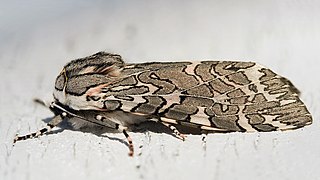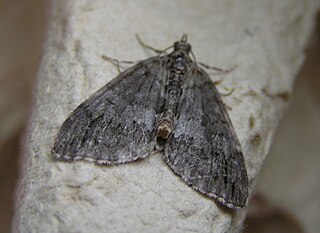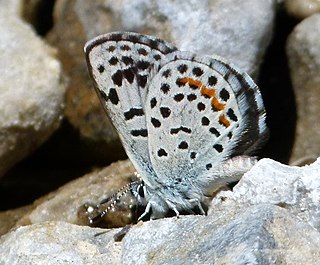
Cisthene is a genus of lichen moths in the family Erebidae. The genus was erected by Francis Walker in 1854.

Arachnis picta, the painted tiger moth, is a moth of the family Erebidae. The species was first described by Alpheus Spring Packard in 1864. It is found in the Southwestern United States and the bordering parts of Mexico.

Hemigrotella is a monotypic moth genus of the family Noctuidae. Its only species, Hemigrotella argenteostriata, is found in southern California. Both the genus and species were first described by William Barnes and James Halliday McDunnough in 1918.

Hydriomena is a genus of moths in the family Geometridae described by Jacob Hübner in 1825.
Renia nemoralis, the tardy renia or chocolate renia moth, is a litter moth of the family Erebidae. It is found in the US from Illinois to south-eastern Massachusetts south to Florida and Texas. The species was first described by William Barnes and James Halliday McDunnough in 1918.

Cisthene plumbea, the lead-colored lichen moth, is a species of moth of the family Erebidae. The species was first described by Richard Harper Stretch in 1885. It is found in eastern North America, from southern New Jersey south to northern Florida, west to Wisconsin and Texas.

Epia is a genus of moths of the family Bombycidae. The genus was erected by Jacob Hübner in 1820.
Cacotherapia angulalis is a species of snout moth in the genus Cacotherapia. It was described by William Barnes and James Halliday McDunnough in 1918 and is known from the US state of California.
Cacotherapia bilinealis is a species of snout moth in the genus Cacotherapia. It was described by William Barnes and James Halliday McDunnough in 1918 and is known from the US state of Arizona.

Euphilotes ancilla, the Rocky Mountain dotted blue, is a species of butterfly of the family Lycaenidae. It is found from Washington south to California and southern Alberta and Saskatchewan south through the Rockies and high plains to Wyoming, Colorado, Utah, and northwestern New Mexico. The species was first described by William Barnes and James Halliday McDunnough in 1918.
Arachnis citra is a moth of the family Erebidae. It was described by Berthold Neumögen and Harrison Gray Dyar Jr. in 1893. It is found in North America, including Arizona, California, Colorado and Utah.
Crambidia impura is a moth of the family Erebidae. It was described by William Barnes and James Halliday McDunnough in 1913. There are two disjunct populations. It has been recorded from southern Rocky Mountain states, the Yukon and northern British Columbia and Alberta. The habitat consists of stabilized sand dunes dominated by open jack pine forests.
Crambidia pura, the pure lichen moth, is a moth of the family Erebidae. It was described by William Barnes and James Halliday McDunnough in 1913. It is found in North America, including Arizona, Florida, Georgia, Kentucky, Maryland, Mississippi, New Jersey, North Carolina, Ohio, Ontario, South Carolina, Tennessee, Texas and Wisconsin.
Cisthene barnesii, or Barnes' lichen moth, is a moth of the family Erebidae. It was described by Harrison Gray Dyar Jr. in 1904. It is found in the US Rocky Mountain region, from southern Montana and western North Dakota to the border with Mexico in Arizona and New Mexico. The habitat consists of dry bunchgrass steppe.
Cisthene conjuncta, the white-streaked lichen moth, is a moth of the family Erebidae. It was described by William Barnes and James Halliday McDunnough in 1913. It is found in southern Texas.
Cisthene juanita is a moth of the family Erebidae. It was described by William Barnes and Foster Hendrickson Benjamin in 1925 and is found in the United States in southern Arizona.
Cisthene subrufa, the Tamaulipan lichen moth, is a moth of the family Erebidae. It was described by William Barnes and James Halliday McDunnough in 1913. It is found in the United States in Arizona and from San Benito, Texas south to Veracruz in Mexico.
Hadena amabilis is a moth in the family Noctuidae. It was described by William Barnes and James Halliday McDunnough in 1918. It is found in the US state of California.
Comadia albistrigata is a moth in the family Cossidae first described by William Barnes and James Halliday McDunnough in 1918. It is found in North America, where it has been recorded from Arizona, New Mexico and Texas.
Cornifrons actualis is a moth in the family Crambidae. It was described by William Barnes and James Halliday McDunnough in 1918. It is found in North America, where it has been recorded from Arizona, California, Montana, Nevada, Texas and Utah. The habitat consists of deserts.







